Test Your Mettle With This Full-Body Kettlebell Workout
Five moves, five rounds, no rest – are you ready for this?

There are several ways to make a workout more challenging. The most common are to lift a heavier weight and to increase the number of sets or reps, but an underrated option is to decrease the amount of time you rest. This can up the ante considerably without needing to pile on more weight or train for longer – in fact you’ll be done even quicker.
If you’re really feeling brave, you can remove rest periods from your workout entirely. That’s what this full-body kettlebell workout from Michael Chapman, head trainer and owner of F45 Tottenham Court Road, does. Aim to roll through all five rounds of the circuit without any breaks.
That probably won’t happen on your first attempt, but it’s something to make a note of and keep in mind when you come back and try the workout again – you can measure your progression not only by the weight you use but also by how little rest you need.
How To Do This Workout
Complete five rounds of the following five-exercise circuit, doing 20 reps of each exercise. The workout will get your heart pumping for a cardio benefit, and will increase your strength and core stability.
“Challenge yourself to work continuously through the five sets without taking a rest between exercises,” says Chapman. “Break only when you need to.”
Full-Body Kettlebell Workout
1 Kettlebell swing
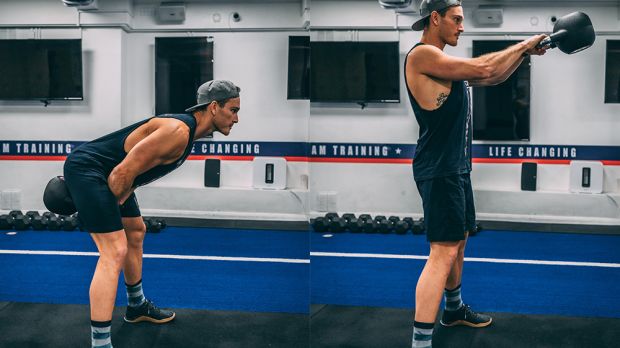
Reps 20
Targets Back, shoulders, glutes, hamstrings, grip strength
Sign up for workout ideas, training advice, reviews of the latest gear and more.
Stand with your feet shoulder-width apart and hold a kettlebell by the handle in both hands in front of you. Keeping your back straight throughout, take the kettlebell back between your legs, then drive through the hips to swing it up in front of you. Then control the swing back down through your legs.
“It’s essential to ensure the movement is generated by hinging your hips and not squatting,” says Chapman. “The kettlebell should reach eye level at the apex of the swing.
“Choose a heavy kettlebell for this move – it’ll really challenge your grip strength. If no heavy kettlebells are available, you can use a band to create more resistance in the swing.”
2 Single-arm kettlebell overhead press
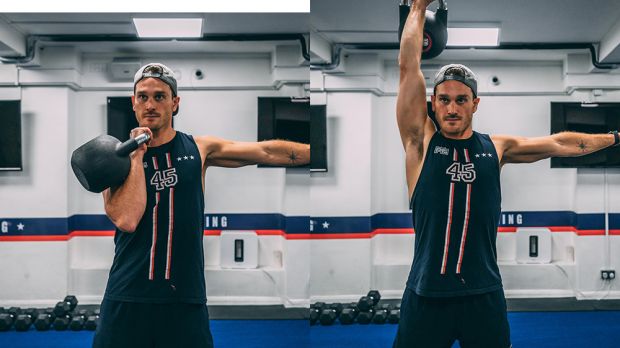
Reps 20 total (do batches of five each side)
Targets Shoulder, core stability
Stand with your feet shoulder-width apart. Start with the kettlebell racked in front of your chest, with your forearm vertical. Press the kettlebell overhead rotating your wrist so your palm faces forwards. Fully lock out the elbow at the top of movement and pause for half a second to take a breath and steady your body, then lower the kettlebell under control.
"Given the uneven loading pattern through the body of the exercise, you need to stay strong in your core to ensure your hips do not sway or slide laterally through the push,” says Chapman.
3 Single-arm kettlebell overhead walking lunge
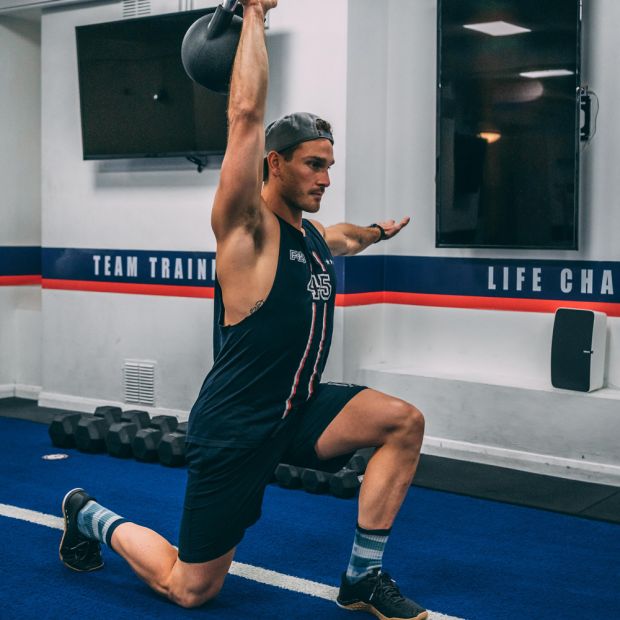
Reps 20 each side
Targets Shoulders, legs and core stabilisers
To prepare for the exercise, press a light kettlebell overhead and lock out your arm. Then step forwards into a lunge, keeping the kettlebell overhead. Keeping your torso low and stable, bring your back leg through and step into another forward lunge. Do 20 walking lunges in one direction with one arm overhead, then turn around and change arms to walk back.
“Ensure your back knee drops to brush the ground, but don’t let it bounce,” says Chapman. “And make sure your elbow stays locked out throughout. The position of the kettlebell is crucial: your arm should be extended vertically the whole time so force travels down through it – don’t let it move to the side, back or forwards.”
See related :
- The Best Kettlebells: Plus, Black Friday Deals On The Best Kettlebells
- The Best Kettlebell Exercises For All Levels Of Gym-Goer
- The Best Kettlebell Workouts For Strength, Cardio And Fat Loss
4 Double kettlebell squat and alternating overhead press
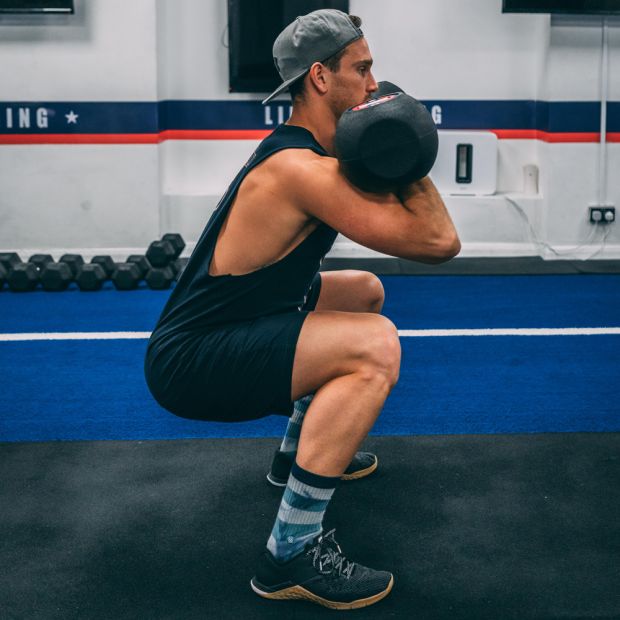
Reps 10 each side
Targets Legs, arms, shoulders, core stabilisers
Holding two kettlebells in the front rack position, lower into a deep squat position. Once your hip crease is in line with top of your knees, drive back to standing and extend one arm to full overhead lock-out position, while the other kettlebell remains racked. Repeat but on the next rep, take the other arm to full lock-out position.
“Your spine must stay tall, straight and neutral,” says Chapman. “Ensure you do not round the thoracic spine [mid/upper back] during the squat even though the kettlebells are pulling you forwards, keep your centre of balance over your heels.”
5 Kettlebell deadlift to press-up
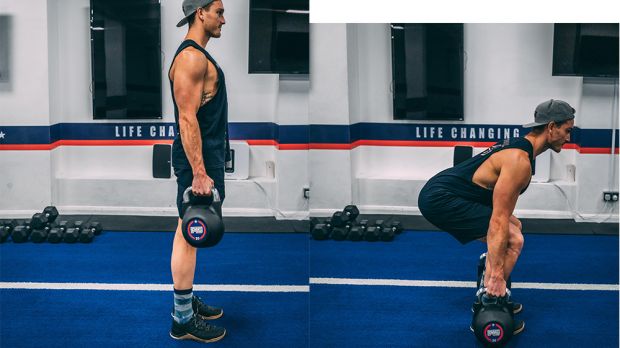
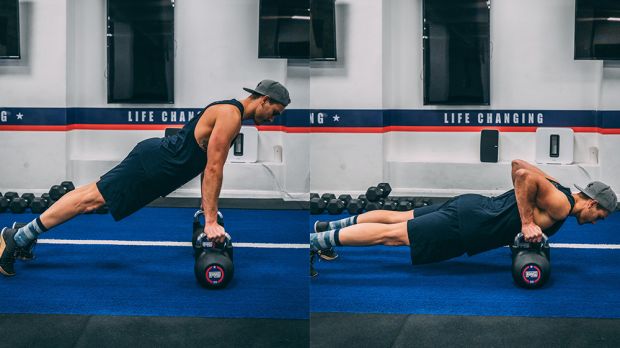
Reps 20
Targets Legs, shoulders, chest
Stand holding two kettlebells by your sides. Squat to lower the kettlebells to the floor, placing them to the outside of each ankle, but keep holding the handles. Once the kettlebells are stable, kick your feet back so you end in a press-up position – hands still on the kettlebells – with your arms extended. Lower your chest towards the ground between the kettlebells for a deep press-up, then drive back up to full arm extension. At the top of the press-up, brace your shoulders to keep yourself stable and jump your feet up so that they are just inside the kettlebells. Drive up through your heels and lift the kettlebells to end standing tall with a proud chest.
“Make sure your back is straight for the deadlift component, and that you’re not rounding the thoracic spine,” says Chapman.

Nick Harris-Fry is a journalist who has been covering health and fitness since 2015. Nick is an avid runner, covering 70-110km a week, which gives him ample opportunity to test a wide range of running shoes and running gear. He is also the chief tester for fitness trackers and running watches, treadmills and exercise bikes, and workout headphones.
